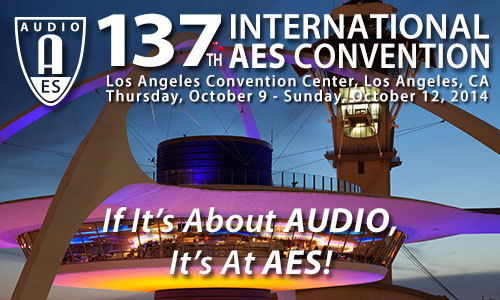AES Los Angeles 2014
Engineering Brief EB5
EB5 - eBriefs—Papers Session 3
Saturday, October 11, 5:00 pm — 6:15 pm (Room 309)
Chair:
Ville Pulkki, Aalto University - Espoo, Finland; Technical University of Denmark - Denmark
EB5-1 Comparison and Contrast of Reverberation Measurements in Grace Cathedral San Francisco—Wieslaw Woszczyk, McGill University - Montreal, QC, Canada; Durand R. Begault, NASA Ames Research Center - Moffett Field, CA, USA; Amanda G. Higbie, Oxford Acoustics - Oxford, MS, USA
In 2001 and 2013 the authors made separate and contrasting acoustical measurements of reverberation within Grace Cathedral, a gothic-style church located in San Francisco notable for its long reverberation time and immersive sound quality for musical performance. Both measurements used different, non-standard methods for generating and
capturing the reverberant sound field. This paper explores the synergy between both sets of measurements for both recording applications and for understanding spatial hearing in large spaces. Applications include manipulation of the perceived size of relatively smaller enclosures having multiple coupled spaces and for improving the long term habitability of space stations, lunar outposts, or other confined spaces.
Engineering Brief 178 (Download now)
EB5-2 The Design of Dolby ATMOS Post Production Theaters—Andrew Munro, Munro Acoustics, Dynaudio Acoustics - London, UK; APRS director
The introduction of Dolby ATMOS has raised several questions concerning the optimum design of the room acoustics for smaller dubbing theaters where the number of speakers and the associated hardware has some bearing on the room as a whole. It is also apparent that compact speaker systems and a flexible approach to installation opens the scope for multi-channel sound installations. The author compares several installation and also compares these with an alternative approach using the IOSONO system.
Engineering Brief 179 (Download now)
EB5-3 Mobile and Variable Absorption Product that Includes Low Frequencies—Niels Adelman-Larsen, Flex Acoustics - Copenhagen, Denmark
At amplified music concerts, from medium sized venues to the biggest arenas, low frequency reverberation is known to be the primary source for an undefined sound with low clarity, even close to the loud speakers. Therefore, means for providing additional low frequency absorption is always a concern. Several layers of fabric at various distances from reflecting surfaces has usually been the best option. Still this method provides a relatively modest absorption coefficient in the important 63 and 125 Hz octave bands, while damping the high frequencies which the audience absorbs well, also due to the high Q of loud speakers at higher frequencies. A new, patented technology of inflated, ultra thin plastic membranes seems to solve this challenged in both multipurpose venues that need to adjust their acoustics at the push of a button, or in halls and arenas that only occasionally present amplified music and need to be treated for the event. This paper presents briefly the technology with cases from differently sized halls and arenas.
Engineering Brief 180 (Download now)
EB5-4 Ellipsoidal Reflector for Measuring Oto-Acoustic Emissions—Ville Pulkki, Aalto University - Espoo, Finland; Technical University of Denmark - Denmark; Vesa Heiskanen, Aalto University - Espoo, Finland; Bastian Epp, Technical University of Denmark - Denmark
A truncated prolate ellipsoidal reflector having the ear canal of a listener at one focal point and large-diaphragm low-noise microphone at the other focal point is proposed for free-field recordings of oto-acoustic emissions. A prototype reflector consisting of three pieces is presented, which enables measuring the response of the system with different truncations. The response of the system is measured with a miniature loudspeaker, and proof-of-concept measurements of oto-acoustic emissions are presented. The effect of truncation and other physical parameters to the performance of the system are discussed.
Engineering Brief 181 (Download now)
EB5-5 Key Sonic Characteristics Voice Identification Analysis and the Courts—Thomas Guzman-Sanchez, GS Media Lab - Northridge, CA, USA
The paper presents a voice identification analysis technique based on the analysis and comparison of four key sonic/acoustic characteristics. The proposed solution provides scientific method of analyzing voice or audio recordings and accessing similarities or differences for uses of identification. The technique utilizes five different types of preparation and analysis generating multiple results that can be applied for comparison. The function is similar to a police line-up except this is done with audio recordings. The proposed analysis will provide an accurate process in accessing voice identification.
Engineering Brief 182 (Download now)
